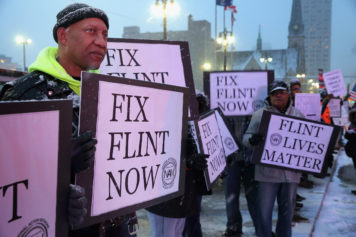What is environmental racism, and what does it have to do with the water crisis in Flint, Michigan?
The Energy Justice Network defines environmental racism as “the disproportionate impact of environmental hazards on people of color.” The term refers to the ways in which Black, Brown and poor people are disproportionately exposed to pollution and waste, dumps, toxic facilities, plants and the like, a legacy of racial and economic segregation.
After a 20-year study, sociologist Robert Bullard found “race to be more important than socioeconomic status in predicting the location of the nation’s commercial hazardous waste facilities.” He found, for example, that Black children are five times more likely to suffer from lead poisoning than their white peers, while people of color disproportionately live in communities with hazardous waste facilities.
The New York Times notes that the word “race” does not appear anywhere in the 274 pages of emails released by Michigan Gov. Rick Snyder relating to the Flint water crisis, the decision to replace the city’s water source — Detroit — with the Flint River, and the poisoning of the city’s water supply with lead. But that is not the point, as environmental activists argue that Flint has environmental racism written all over it.
As the Times points out, decisions related to the environment involve political power, so that often, for example, unwanted garbage incinerators are built in Black neighborhoods where people lack the influence to stop them. As for Flint — a majority Black city in a state that is Republican-dominated and where Blacks are only 14 percent of the state population — they simply do not have any sway in the state capital of Lansing.
While the emails make no mention of race, they do smack of politics, which is highly race-based, especially when dealing with a conservative Republican administration and a Black, Democratically controlled city. State officials called Flint activists the “anti-everything group” that complains about everything, and accused them of attempting to turn the lead issue “into a political football.” Rep. Dan Kildee, a Democrat who represents Flint, called race “the single greatest determinant of what happened in Flint.”
He also said, “They treated it like it was a public-relations problem not a public problem for the people in Flint.”
Further, these emails demonstrated a longstanding indifference to the very real concerns of Flint residents. As Vox notes, State Rep. Sheldon Neeley sent Gov. Snyder a letter in January 2015 asking for help for Flint. He wrote that the city “stands on the precipice of civil unrest” because of mistrust of the water supply, and asked the state of Michigan to forgive a $21 million debt Flint owed to a state fund for improving water safety. But state environmental officials dismissed the water safety issues and insisted the risk was not a concern, suggesting the city was stirring things up in order to obtain state money. According to the Detroit Free Press, Neeley sent the letter to [email protected], an e-mail address for constituents. Moreover, the state lawmaker contends that when Snyder released the email messages, that particular message, among others, was not included.
Dennis Muchmore, Snyder’s chief of staff, sounded the alarm on the crisis, which was received with lukewarm response from state government. But he could not understand why the state would be responsible for the crisis, even as Flint was taken over by a state-appointed emergency manager who decided to switch the water supply. Meanwhile, one email dismissed troubling findings on lead levels from a pediatrician as “data.”
[Michigan Department of Health and Human Services] epidemiologists continue to review the “data” provided by a Hurley hospital physician that showed an increase in lead activity following the change in water supply. While we continue to review this data, we have stated publicly that Hurley conducted their analysis in a much different way than we do at the department. Hurley used two partial years of data, MDHHS looked at five comprehensive years and saw no increase outside the normal seasonal increases. The Hurley review was also a much smaller sample than MDHHS data as ours includes all hospital systems in Flint as well as outside laboratories.
Downplaying and covering up clear evidence of lead in the drinking water, dismissing activists’ concerns, and making fun of Flint residents whose children are exposed to lead poisoning, Gov. Snyder and other state officials have created a textbook case of environmental racism. And although we do not now the entire story, we do know that Black children have lead poisoning, Snyder knew it, and that this would not happen to white children.



